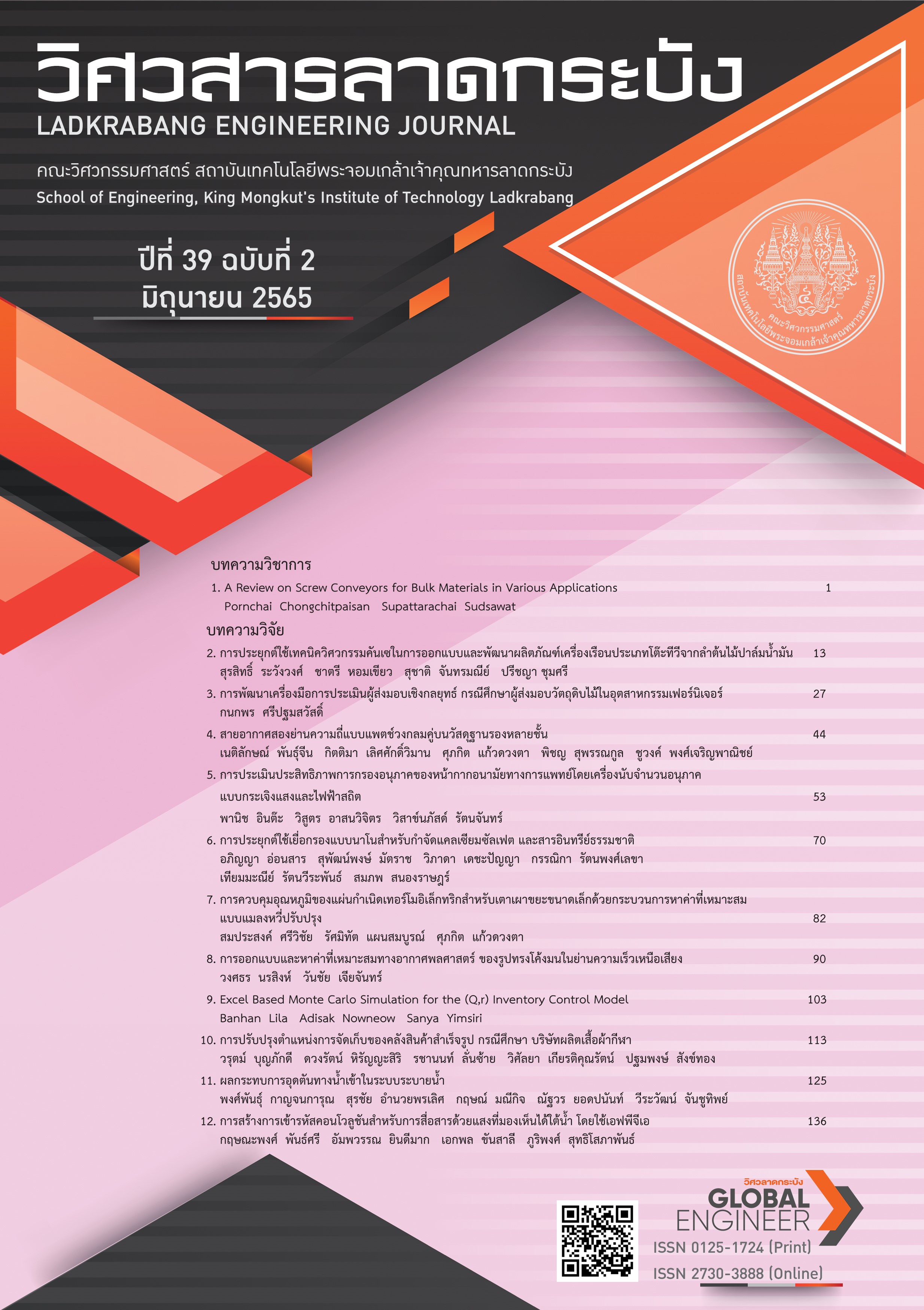การประเมินประสิทธิภาพการกรองอนุภาคของหน้ากากอนามัยทางการแพทย์โดยเครื่องนับจำนวนอนุภาคแบบกระเจิงแสงและไฟฟ้าสถิต
คำสำคัญ:
โควิด19, หน้ากากอนามัย, เครื่องนับจำนวนอนุภาคแบบกระเจิงแสง, เครื่องนับจำนวนอนุภาคแบบไฟฟ้าสถิตบทคัดย่อ
บทความวิจัยนี้มีวัตถุประสงค์เพื่อเปรียบเทียบประสิทธิภาพการนับจำนวนอนุภาคของเครื่องแบบกระเจิงแสงและแบบไฟฟ้าสถิต สำหรับใช้ประเมินประสิทธิภาพในการกรองอนุภาคของหน้ากากอนามัยทางการแพทย์ ในงานวิจัยนี้ได้เลือกตัวอย่างหน้ากากอนามัยทางการแพทย์ที่ผ่านการรับรองจาก อย. สำหรับนำมาใช้ในการทดสอบประสิทธิภาพในการกรองอนุภาคตามมาตรฐาน ASTM F2299-03 กับอนุภาคทรงกลมชนิดพอลิสไตรีน ลาเท็กซ์ ขนาดเส้นผ่านศูนย์กลาง 0.1, 0.5, 1.0 และ 1.5 µm ที่ความเร็วด้านหน้าเท่ากับ 10.6 cm/s พื้นที่ทดสอบเท่ากับ 17.8 cm2 ทำการวัดความเข้มข้นเชิงจำนวนก่อนและหลังผ่านหน้ากากตัวอย่างด้วยเครื่องนับจำนวนอนุภาคแบบกระเจิงแสงและไฟฟ้าสถิตเพื่อเปรียบเทียบความแตกต่างของค่าประสิทธิภาพในการกรองอนุภาคของทั้ง 2 เครื่อง จากผลการทดลองพบว่าค่าประสิทธิภาพในการกรองอนุภาคของทั้ง 2 เครื่องอยู่ในช่วงค่า 95.38–98.61%โดยความแตกต่างของค่าความผิดพลาดร้อยละสัมบูรณ์เฉลี่ยของประสิทธิภาพในการกรองอนุภาคระหว่างเครื่องนับจำนวนอนุภาคแบบกระเจิงแสงและไฟฟ้าสถิตเท่ากับ 0.99, 2.03, 1.84 และ 1.79 สำหรับอนุภาคขนาด 0.1, 0.5, 1.0 และ 1.5 µm ตามลำดับ ผลจากการเปรียบเทียบแสดงให้เห็นว่าเครื่องนับจำนวนอนุภาคแบบไฟฟ้าสถิตสามารถใช้ในการทดสอบประสิทธิภาพในการกรองอนุภาคได้เทียบเคียงกับเครื่องนับจำนวนอนุภาคแบบกระเจิงแสงตามที่มาตรฐาน ASTM F2299-03 กำหนดไว้
References
COVID-19 situation report, Department of Disease Control, Jan. 4, 2022. [Online]. Available: https://covid19.ddc.moph.go.th/
K. O’Dowd, K. M. Nair, P. Forouzandeh, S. Mathew, J. Grant, R. Moran, J. Bartlett, J. Bird and S. C. Pillai, “Face Masks and Respirators in the Fight Against the COVID-19 Pandemic: A Review of Current Materials, Advances and Future Perspectives,” Materials, vol. 13, no. 15, pp. 1–27, 2020, doi: 10.3390/ma13153363.
N. El-Atab, N. Qaiser, H. Badghaish, S. F. Shaikh and M. M Hussain, “Flexible Nanoporous Template for the Design and Development of Reusable Anti-COVID-19 Hydrophobic Face Masks,” ACS Nano, vol. 14, no. 6, pp. 7659–7665, 2020, doi: 10.1021/acsnano.0c03976.
E. E Sickbert-Bennett, J. M. Samet, P. W. Clapp, H. Chen, J. Berntsen, K. L. Zeman, H. Tong, D. J. Weber and W. D. Bennett, “Filtration Efficiency of Hospital Face Mask Alternatives Available for Use During the COVID-19 Pandemic,” JAMA Internal Medicine, vol. 180, no. 12, pp.1607–1612, 2020, doi: 10.1001/jamainternmed. 2020.4221.
A. Konda, A. Prakash, G. A. Moss, M. Schmoldt, G. D. Grant and S. Guha, “Aerosol Filtration Efficiency of Common Fabrics Used in Respiratory Cloth Masks,” ACS Nano, vol. 14, no. 5, pp.6339–6347, 2020, doi: 10.1021/acsnano.0c03252.
O. Aydin, B. Emon, S. Cheng, L. Hong, L. P. Chamorro, M. T. A. Saif, “Performance of Fabrics for Home-made Masks Against the Spread of COVID-19 through Droplets: A Quantitative Mechanistic Study,” Extreme Mechanics Letters, vol. 40, 2020, Art. no. 100924, doi: 10.1016/j.eml.2020.100924.
S. Rengasamy, B. Eimer and R. E. Shaffer, “Simple Respiratory Protection—Evaluation of the Filtration Performance of Cloth Masks and Common Fabric Materials Against 20–1000 nm Size Particles,” The Annals of Occupational Hygiene, vol. 54, no. 7, pp.789–798, 2010, doi: 10.1093/annhyg/meq044.
H. Whiley, T. P. Keerthirathne, M. A. Nisar, M. A. F. White and K. E. Ross, “Viral Filtration Efficiency of Fabric Masks Compared with Surgical and N95 Masks,” Pathogens, vol. 9, no. 9, pp.762–769, 2020, doi: 10.3390/pathogens9090762.
C. M. Dugdale and R. P. Walensky, “Filtration Efficiency, Effectiveness, and Availability of N95 Face Masks for COVID-19 Prevention,” JAMA Intern Medicine, vol. 180, no. 12, pp.1612–1613, 2020,doi: 10.1001/jamainternmed.2020.4218.
P. Intra, “Filtration efficiency of surgical masks, fabric masks and respirators available for use during the COVID-19 pandemic in Thailand,” Thai Science and Technology Journal, vol.29, no.5, pp.904–918, 2021.
Automated Filter Tester Model 8130A, TSI Inc., Jan. 12, 2022. [Online]. Available: https://tsi.com/products/filter-testers/automated-filter-tester-8130a/
Automated Filter Tester Model 3160, TSI Inc., Jan. 12, 2022. [Online]. Available: https://tsi.com/ products/filter-testers/automated-filter-tester-3160/
G506 Mask Automatic Filter Performance Tester, Qinsun Instruments Co., Ltd., Jan. 12, 2022. [Online]. Available: http://www.testerinlab.com/products/Others/2018/0316/200.html
Standard Specification for Performance of Materials Used in Medical Face Masks, ASTM F2100-19e1, ASTM International, West Conshohocken, PA, USA, 2019.
42 CFR Part 84 Respiratory Protective Devices, NIOSH, Mar. 4, 1997. [Online]. Available: https://www.cdc.gov/niosh/npptl/topics/respirators/pt84abs2.html
Standard Test Method for Determining the Initial Efficiency of Materials Used in Medical Face Masks to Penetration by Particulates Using Latex Spheres, ASTM F2299/F2299M-03(2017), ASTM International, West Conshohocken, PA. USA, 2017.
P. Intra and N. Tippayawong, “Performance evaluation of an electrometer system for ion and aerosol charge measurements,” Korean Journal of Chemical Engineering, vol. 28, no. 2, pp. 527–530, 2011, doi: 10.1007/s11814-010-0378-1.
P. Intra, A. Yawootti and N. Tippayawong, “An electrostatic sensor for continuous monitoring of particulate air pollution,” Korean Journal of Chemical Engineering, vol. 30, no. 12, pp.2205–2212, 2013, doi: 10.1007/s11814-013-0168-7.
P. Intra and N. Tippayawong, “Development and evaluation of a Faraday cup electrometer for measuring and sampling atmospheric ions and charged aerosols,” Particulate Science and Technology, vol. 33, no. 3, pp. 257–263, 2015, doi: 10.1080/02726351.2014.952392.
P. Intra and N. Tippayawong, “Measurements of ion current from a corona-needle charger using a Faraday cup electrometer,” Chiang Mai Journal of Science, vol. 36, no. 1, pp. 110–119, 2009.
P. Intra, “Electrical aerosol measurement,” in Electrostatic Aerosol Measurement and Control Technology, Bangkok, Thailand: Chula Press, 2019, ch. 10, pp. 177–194.
K. Willeke and P.A. Baron, “Filter collection,” in Aerosol Measurement: Prnciples, Techniques, and Applications, New York, USA: John Wiley & Sons, 1993, ch. 10, pp. 179–205.
TSI 3756 Ultrafine Condensation Particle Counter User’s Guide, TSI Incorporated, Minnesota, USA, 2022, pp. 1–62.
Model 3068B Aerosol Electrometer User’s Manual, TSI Incorporated, Minnesota, USA, 2022, pp. 1–61.
M. Fierz, S. Weimer and H. Burtscher, “Design and performance of an optimized electrical diffusion battery,” Journal of Aerosol Science, vol. 40, no.2, pp.152–163, 2008, doi: 10.1016/j.jaerosci.2008.09.007.
M. Fierz, L. Scherrer and H. Burtscher, “Real-Time Measurement of Aerosol Size Distributions with an Electrical Diffusion Battery,” Journal of Aerosol Science, vol. 33, no.7, pp. 1049–1060, 2002, doi: 10.1016/S0021-8502(02)00057-5.
S. S. Park, C. J. Lee, S. W. Kim, S. B. Lee, G. N. Bae and K. C. Moon, “A Novel Ultrafine Particle Measurement System with an Electrometer,” in 48th Midwest Symposium on Circuits and Systems, Covington, KY, USA, Aug. 2005, pp. 227–230, doi: 10.1109/MWSCAS.2005.1594080.
H. W. Gäggeler, U. Baltensperger, M. Emmenegger, D. T. Jost, A. Schmidt-Ott, P. Haller and M. Hofmann, “The Epiphaniometer, a New Device for Continuous Aerosol Monitoring,” Journal of Aerosol Science, vol. 20, no. 5, pp. 557–564, 1989, doi: 10.1016/0021-8502(89)90101-8.
T. Johnson, S. Kaufman and A. Medved, “Response of an Electrical Aerosol Detector based on a Corona Jet Charger,” in 6th International ETH Conference on Nanoparticle Measurement, Aug. 2002, Zurich, Switzerland, pp. 1–12.
S. Kimoto, K. Mizota, M. Kanamaru, H. Okuda, D. Okuda and M. Adachi, “Aerosol Charge Neutralization by a Mixing-Type Bipolar Charger using Corona Discharge at High Pressure,” Aerosol Science and Technology, vol. 43, no.9, pp.872–880, 2009, doi: 10.1080/02786820902998381.
Downloads
เผยแพร่แล้ว
How to Cite
ฉบับ
บท
License
Copyright (c) 2022 คณะวิศวกรรมศาสตร์ สถาบันเทคโนโลยีพระจอมเกล้าเจ้าคุณทหาร

This work is licensed under a Creative Commons Attribution-NonCommercial-NoDerivatives 4.0 International License.
บทความที่ได้รับการตีพิมพ์เป็นลิขสิทธิ์ของคณะวิศวกรรมศาสตร์ สถาบันเทคโนโลยีพระจอมเกล้าเจ้าคุณทหารลาดกระบัง
ข้อความที่ปรากฏในบทความแต่ละเรื่องในวารสารวิชาการเล่มนี้เป็นความคิดเห็นส่วนตัวของผู้เขียนแต่ละท่านไม่เกี่ยวข้องกับสถาบันเทคโนโลยีพระจอมเกล้าเจ้าคุณทหารลาดกระบัง และคณาจารย์ท่านอื่นๆในสถาบันฯ แต่อย่างใด ความรับผิดชอบองค์ประกอบทั้งหมดของบทความแต่ละเรื่องเป็นของผู้เขียนแต่ละท่าน หากมีความผิดพลาดใดๆ ผู้เขียนแต่ละท่านจะรับผิดชอบบทความของตนเองแต่ผู้เดียว






